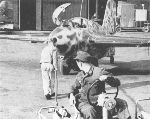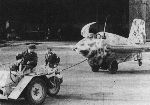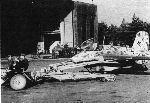Me 163B 'White 14'
This page shows all known pictures of Komet 'White 14', a fine example of the mottled camouflage that was used on many Komets. Not much is (yet) known about this aircraft except for the pictures. This aircraft was researched by Bob Chubb (who identified many of the photographs while researching the camouflage in order to paint his RC model) and Nigel Moore (who's also intrigued by this particular aircraft). This page resulted largely because of their interest in this very nice example.
Identity
Not much is known about this aircraft except for its code 'White 14'. No Werknummer is known or visible in the pictures shown below. It is equipped with MK 108 cannons, which eliminates the first 40 or so pre-production aircraft. It appears that at least some pictures were taken at Bad Zwischenahn, suggesting it belongs to Erprobungskommando 16.
Scheuch-Schlepper demonstration model
Almost all (or all) known photographs show 'White 14' being used as a demonstration model for the Scheuch-Schlepper. It is very likely that all pictures were taken from one piece of film which may have been shot in the the very same day.
1. | Six pictures of 'White 14' parked in front of a hangar, then being coupled to the Schlepper, towed past a train, and then finally arriving at the runway threshold. Possibly the combination of the hangar and the rail track could lead to the identification of the airfield. This would make possible some sort of dating for the piece of film.
| |
|
|
|
2.| White 14 being returned to the hangar loaded on the hydraulic Scheuch-Schlepper.
| |
|
|
|
Camouflage discussion
The basic camouflage consists of a completely mottled fuselage and solid-colored wings. The mottle pattern is very irregular, with very small and very large mottles. On the rudder the mottles blend into each other forming a large wide stripe. This stripe is a also a good way to recognize this particular aircraft. The mottles cover nearly the whole fuselage, the only exception being the area under the wing root. Unfortunately all pictures show the left side only. The wings are likely painted in a splinter pattern. On the wing roots the solid camouflage has a soft edge blending into the fuselage camouflage.
The colors used on this aircraft are very difficult to judge. The fuselage base color is likely to be RLM 76 (like 'White 05') but RLM 02 also remains a possibility. The wings appear to be painted in dark colors, but without some sort of photo dating this can range from an RLM 70/71 combination (like 'White 05') to late war colors RLM 81/83. If the aircraft is an early example at Bad Zwischenahn, the RLM 70/71 combination is quite likely. The colors of the mottles look similar to those used on the wings. It's hard to see whether one or two colors were used for the mottling.
The cockpit interior color varies considerably in the pictures. One would expect RLM 66 (a dark grey) but this only shows in the last picture (loaded on the hydraulic Scheuch-Schlepper). In the first two pictures the rear bulkhead appears to be painted in a very light color, but you're looking at the rear view windows, not the bulkhead itself. That can be seen bordering the headrest, and then it appears dark too. The interior of the canopy frame also appears dark.
The markings visible in the picture: a standard black and white Balkenkreuz on the rear fuselage and similarly standard black and white swastika in the standard positions. The code 'White 14' is painted on in a large size; the non-standard font suggests it was handpainted. The code could possibly also have been painted in yellow, although most pictures show no contrast between the white of the Balkenkreuz and the code. No unit markings are painted on the nose. The crosses on the wings can not be seen in the pictures.
Another 'White 14'
Another 'White 14' existed too. It had more dense mottling, and the mottling was more in the form of short stripes than spots. No further information is available.
Return to Me 163B page







